
 One of the most fascinating areas of world coin collecting is that of Spanish colonials. These coins circulated freely during the colonial period of the New World, both North America and South America. You can find essentially the same coins minted in the Spanish colonies of Bolivia, Chile, Columbia, Guatemala, Mexico, and Peru, from the early 1600s to the early 1800s. They circulated as far north as Canada and as far east as Florida.
One of the most fascinating areas of world coin collecting is that of Spanish colonials. These coins circulated freely during the colonial period of the New World, both North America and South America. You can find essentially the same coins minted in the Spanish colonies of Bolivia, Chile, Columbia, Guatemala, Mexico, and Peru, from the early 1600s to the early 1800s. They circulated as far north as Canada and as far east as Florida.
These coins look alike, with subtle differences in mint marks and other small details, so it takes detailed knowledge to tell them apart. This page discusses some these details and gives approximate values. But, this is only a web page. Coin catalogs and reference books have much more detail. For instance, Spanish colonies in Dominican Republic, Venezuela, Nicaragua, and the Philippines produced small amounts of coinage, but they are not included here. There are also pre-1600 coins and small denominations not addressed. You can learn from this summary, but it is just a starting point.
It is important to know the kings of Spain during this period, as their names and portraits appear on many coins.
Methods of manufacture - There are two major types of Spanish colonials, and several sub-types. At the highest level there are cob coins and there are milled coins. Both come in gold and silver.
| Cob | Milled | Silver |  |
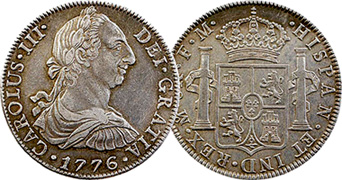 |
Gold | 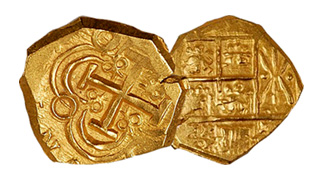 |
 |
The rich deposits of precious metal in the New World were too much for Spanish royalty to resist. They were therefore exploited and carried back to Spain. To hasten this process, bars of silver and gold were hacked into chunks of proper weight and struck with heavy hammers between crude, hard-metal dies. The strike imparted a Spanish pattern, or part of a Spanish pattern, into the coin. The Spanish word cabo (English cob) refers to the end of the bar. The size, shape and impression of these cobs was highly irregular. However, they were of proper weight, and that is what mattered to Spanish officials. If a cob was overweight, the minter simply clipped a piece off.
Eventually the crude manufacture of cob coins was replaced by more modern minting technology. Milled coins were made by rolling the silver and gold into sheets of uniform thickness and punching out coin blanks, or planchets, for striking in large screw presses. The presses did a much better job than the hammers used to produce cobs.
 Denominations - There are two major denominations of Spanish colonials: reales for silver coins and escudos for gold coins. The denominations have associated numeric values, e.g., one-quarter, one-half, 1, 2, 4, and 8. You can often tell the denomination by 'R' and 'S' marking for reales and escudos. For example, R = 1/2 real, 1R = 1 real, 2R = 2 reales, 2S = 2 escudos, and 8S = 8 escudos. There are 16 reales in one escudo.
Denominations - There are two major denominations of Spanish colonials: reales for silver coins and escudos for gold coins. The denominations have associated numeric values, e.g., one-quarter, one-half, 1, 2, 4, and 8. You can often tell the denomination by 'R' and 'S' marking for reales and escudos. For example, R = 1/2 real, 1R = 1 real, 2R = 2 reales, 2S = 2 escudos, and 8S = 8 escudos. There are 16 reales in one escudo.
Perhaps you have heard American folk tales with mysterious references to gold doubloons and pieces of eight. The escudos are the doubloons, and the reales are the pieces. In fact, the US monetary system has roots in Spanish reales, with 8 reales equivalent to one dollar, 4 reales to 50 cents, 2 reales 25 cents (two bits), one real 10 cents, and half real 5 cents.
The graphic figure on the left shows some typical denominational markings. A stand-alone number, 1, 2, 4, or 8, with or without an R or S, indicates denomination. Of course the size and weight of the coin indicates denomination as well. Generally, 8 reales contain about 0.8 troy ounces of silver and 8 escudos contain about 0.8 troy ounces of gold.
Mint Marks - Mint marks are important because they indicate the country of origin. The table below summarizes a few of the major mint marks for New World Spanish colonials. Spain herself is not included.
| Country | Mint Mark | City |
| Bolivia |  |
Potosi |
| Chile |  |
Santiago |
| Colombia |  |
Bogota |
| Colombia |  |
Bogota |
| Colombia |  |
Popayan |
| Colombia |  |
Popayan |
| Guatemala |  |
Nueva Guatemala |
| Guatemala |  |
Guatemala City |
| Mexico |  |
Mexico City |
| Peru |  |
Cuzco |
| Peru |  |
Cuzco |
| Peru |  |
Lima |
| Peru |  |
Lima |
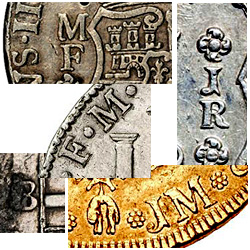 Assayer Initials - In addition to mint marks, the collector should discern assayer initials. Assayers were people at the mints whose job it was to ensure proper weight and purity of the precious metal in the coin. Usually their initials appear as two or more letters prominently displayed on the coin, but sometimes a single letter appears. See the graphic at left for examples.
Assayer Initials - In addition to mint marks, the collector should discern assayer initials. Assayers were people at the mints whose job it was to ensure proper weight and purity of the precious metal in the coin. Usually their initials appear as two or more letters prominently displayed on the coin, but sometimes a single letter appears. See the graphic at left for examples.
Summary - To completely identify a Spanish colonial coin, you need:
Armed with the background information above, we now look at individual design elements for Spanish colonials and give a hint of approximate value. No surprise, smaller coins such as 1 real or 1 escudo are generally worth less than larger coins such as 8 reales or 8 escudos. And, as always in coin collecting, coins in better condition are worth much more than coins in poorer condition. The descriptions below account for the major design elements for Spanish colonial coinage. There are a few designs not covered which are either very early or of very small denomination.
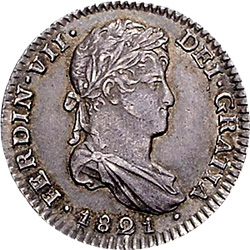 Silver with king's bust - Milled coins with a King's likeness are generally newer than other types, spanning from Carol III to Ferdinand VII (1759 to 1833). For large 8 reales coins values usually hover around the $200 mark for well-preserved coins. Curiously, 4 reales are generally more rare and command two or three times the value of 8 reales. A one real in average circulated condition is worth approximately $60 US dollars.
Silver with king's bust - Milled coins with a King's likeness are generally newer than other types, spanning from Carol III to Ferdinand VII (1759 to 1833). For large 8 reales coins values usually hover around the $200 mark for well-preserved coins. Curiously, 4 reales are generally more rare and command two or three times the value of 8 reales. A one real in average circulated condition is worth approximately $60 US dollars.
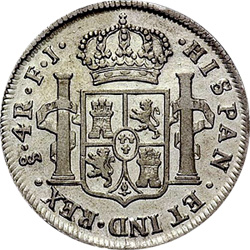 Crowned arms between pillars - This pattern is always paired with silver busts. The example in the picture is a 4 reales (4R) from Chile (Santiago mint) with assayer initials F and J. These are sometimes called pillar dollars, but there are other Spanish colonials with pillars, so the name is misleading. The coat of arms with lions and castles is a classic symbol of Spain.
Crowned arms between pillars - This pattern is always paired with silver busts. The example in the picture is a 4 reales (4R) from Chile (Santiago mint) with assayer initials F and J. These are sometimes called pillar dollars, but there are other Spanish colonials with pillars, so the name is misleading. The coat of arms with lions and castles is a classic symbol of Spain.
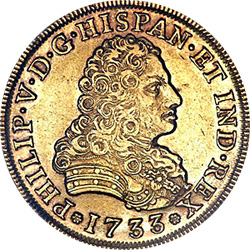 Gold with king's bust - Bust gold coins date as far back as Philip V and span through Ferdinand VII (1700 to 1833). These are valuable coins no matter how you look at them. Even small 1 escudo coins from Ferdinand sell near $400 US dollars in well preserved condition. Large 8 escudos can easily reach past $1000, and rare dates and early dates can hit $10,000 or higher. For instance, a 1764 8 escudos from Mexico with assayers MF catalogs at $11500 in well preserved condition.
Gold with king's bust - Bust gold coins date as far back as Philip V and span through Ferdinand VII (1700 to 1833). These are valuable coins no matter how you look at them. Even small 1 escudo coins from Ferdinand sell near $400 US dollars in well preserved condition. Large 8 escudos can easily reach past $1000, and rare dates and early dates can hit $10,000 or higher. For instance, a 1764 8 escudos from Mexico with assayers MF catalogs at $11500 in well preserved condition.
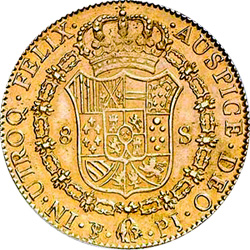 Gold flared arms with Order chain - This is the most recent reverse for bust gold Spanish colonials, starting around 1770. The coat of arms is flared a the top and encircled by a chain. The chain, with a sheepskin at the bottom, is from the Order of the Golden Fleece, an order of chivalry founded in 1430. The example in the picture is an 8 escudos (8S) from Bolivia (Potosi mint) with assayer initials P and J.
Gold flared arms with Order chain - This is the most recent reverse for bust gold Spanish colonials, starting around 1770. The coat of arms is flared a the top and encircled by a chain. The chain, with a sheepskin at the bottom, is from the Order of the Golden Fleece, an order of chivalry founded in 1430. The example in the picture is an 8 escudos (8S) from Bolivia (Potosi mint) with assayer initials P and J.
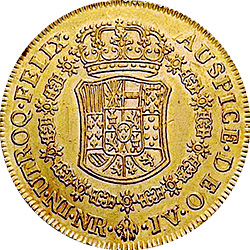 Gold tall arms with Order chain - The coat of arms on earlier (c. 1760 to 1770) bust escudos is slightly taller, slimmer, and less flared than the later design. Values are about the same as the gold bust coins already discussed. The coin in the picture is from Colombia (with the NR mint mark) but the denomination is not shown explicitly. It must be determined from the size and weight of the coin.
Gold tall arms with Order chain - The coat of arms on earlier (c. 1760 to 1770) bust escudos is slightly taller, slimmer, and less flared than the later design. Values are about the same as the gold bust coins already discussed. The coin in the picture is from Colombia (with the NR mint mark) but the denomination is not shown explicitly. It must be determined from the size and weight of the coin.
 Gold royal arms with Order chain - The earliest bust milled gold coins had a royal Spanish arms on the reverse, starting in 1732 and continuing through about 1760. These are generally more valuable than more recent bust gold, cataloging, for instance, near $1000 for a well-preserved escudo and $5000 for a well-preserved 4 or 8 escudos. The same royal arms appears on silver coins. The gold coin in the picture is from Mexico (with the oM mint mark) but the denomination is not shown explicitly. It must be determined from the size and weight of the coin.
Gold royal arms with Order chain - The earliest bust milled gold coins had a royal Spanish arms on the reverse, starting in 1732 and continuing through about 1760. These are generally more valuable than more recent bust gold, cataloging, for instance, near $1000 for a well-preserved escudo and $5000 for a well-preserved 4 or 8 escudos. The same royal arms appears on silver coins. The gold coin in the picture is from Mexico (with the oM mint mark) but the denomination is not shown explicitly. It must be determined from the size and weight of the coin.
 Gold royal arms no chain - Some of the smaller demonination gold bust coins omit the chain around the royal arms. Values are unaffected, or perhaps a tad higher than a chained design. There is also a silver version of this no-chain pattern.
Gold royal arms no chain - Some of the smaller demonination gold bust coins omit the chain around the royal arms. Values are unaffected, or perhaps a tad higher than a chained design. There is also a silver version of this no-chain pattern.
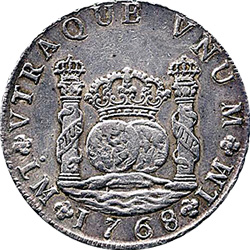 Hemisheres between pillars - These are the pillar dollars most often referred to. The VTRAQUE VNUM (both are one) inscription appears over a Spanish crown that links Old and New Worlds together. The pillars bear a PLUS ULTRA (more beyond) inscription and are usually called the pillars of Hercules because the form a portal to both worlds, approached through the wavy sea beneath. Catalog values for these coins start around $30 US dollars for a worn 1 real and climb to $300 for a well-preserved 8 reales. The sample in the picture comes from Peru (Lima mint mark). Dates span from the 1730s to the 1770s.
Hemisheres between pillars - These are the pillar dollars most often referred to. The VTRAQUE VNUM (both are one) inscription appears over a Spanish crown that links Old and New Worlds together. The pillars bear a PLUS ULTRA (more beyond) inscription and are usually called the pillars of Hercules because the form a portal to both worlds, approached through the wavy sea beneath. Catalog values for these coins start around $30 US dollars for a worn 1 real and climb to $300 for a well-preserved 8 reales. The sample in the picture comes from Peru (Lima mint mark). Dates span from the 1730s to the 1770s.
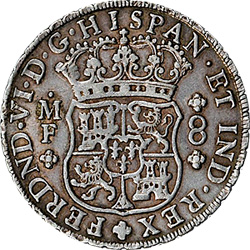 Silver royal arms - This pattern is paired with the Hemisphere between pillars pattern, and approximate values are explained there. These are almost always milled coins, but Guatemala used this pattern on a few cobs between 1733 and 1753. If you have a cob version, figure $25 to $400 catalog values (worn 1 real to well-preserved 8 reales). The coin in the picture is an 8 reales of Fernando VI with assayer initials MF. The other side has the mint mark (Mexico City).
Silver royal arms - This pattern is paired with the Hemisphere between pillars pattern, and approximate values are explained there. These are almost always milled coins, but Guatemala used this pattern on a few cobs between 1733 and 1753. If you have a cob version, figure $25 to $400 catalog values (worn 1 real to well-preserved 8 reales). The coin in the picture is an 8 reales of Fernando VI with assayer initials MF. The other side has the mint mark (Mexico City).
 Silver Jerusalem cross - Silver cobs from Mexico City have a Jerusalem cross on one side. The cross can be plain or with foils around it. Castles and lions appear in the angles of the cross. Cobs like this date back before 1600 to the early 1700s. Values start around $100 for small, poorly preserved coins and can go as high as $1000 for common-date, well-preserved 8 reales. Silver cobs were produced in Bolivia, Colombia, Mexico, and Peru.
Silver Jerusalem cross - Silver cobs from Mexico City have a Jerusalem cross on one side. The cross can be plain or with foils around it. Castles and lions appear in the angles of the cross. Cobs like this date back before 1600 to the early 1700s. Values start around $100 for small, poorly preserved coins and can go as high as $1000 for common-date, well-preserved 8 reales. Silver cobs were produced in Bolivia, Colombia, Mexico, and Peru.
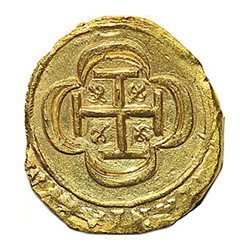 Gold Jerusalem cross - Almost all gold cobs have a Jerusalem cross on one side. The cross has prominent foils around it or a circle of dots. Sometimes castles and lions appear in the angles of the cross, but not always. The pictured coin has a quatrefoil and fluers de lis in the angles. These are very valuable coins. Catalog values start around $2500 for small, poorly preserved specimens and can easily reach $10000 for large, attractive 8 escudos. Gold cobs were produced in Colombia, Mexico, and Peru.
Gold Jerusalem cross - Almost all gold cobs have a Jerusalem cross on one side. The cross has prominent foils around it or a circle of dots. Sometimes castles and lions appear in the angles of the cross, but not always. The pictured coin has a quatrefoil and fluers de lis in the angles. These are very valuable coins. Catalog values start around $2500 for small, poorly preserved specimens and can easily reach $10000 for large, attractive 8 escudos. Gold cobs were produced in Colombia, Mexico, and Peru.
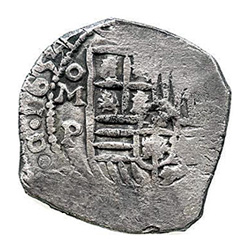 Silver crowned shield - A crowned shield with the Spanish coat of arms is often paired with the Jerusalem cross on silver cobs. Most of the time, only part of the design is actually visible. In the example here, the crown, which sits on top of the shield, is not at all present. But the oM (Mexico City) mint mark is plainly visible, the assayer initial P is visible, and a hint at the date (perhap 1654) also appears. Collectors will pay premiums for visible components such as these.
Silver crowned shield - A crowned shield with the Spanish coat of arms is often paired with the Jerusalem cross on silver cobs. Most of the time, only part of the design is actually visible. In the example here, the crown, which sits on top of the shield, is not at all present. But the oM (Mexico City) mint mark is plainly visible, the assayer initial P is visible, and a hint at the date (perhap 1654) also appears. Collectors will pay premiums for visible components such as these.
 Gold crowned shield - A crowned shield with the Spanish coat of arms is often paired with the Jerusalem cross on gold cobs. Most of the time, only part of the design is actually visible. The example pictured is extraordinary. You can plainly see the crown, the oM (Mexico City) mint mark, the assayer initial I or J, and a clear date of 1714. The denomination does not show on the coin, but from its size and weigth it is easily identified as an 8 escudos. Further, turning to the coin catalogs which list all assayers, we know the intial is J, Jose E deLeon, who served as assayer between 1708 and 1723. This is a very valuable coin. Collectors will pay premiums for visible components such as these. Escudos with shields were produced only in Colombia and Mexico.
Gold crowned shield - A crowned shield with the Spanish coat of arms is often paired with the Jerusalem cross on gold cobs. Most of the time, only part of the design is actually visible. The example pictured is extraordinary. You can plainly see the crown, the oM (Mexico City) mint mark, the assayer initial I or J, and a clear date of 1714. The denomination does not show on the coin, but from its size and weigth it is easily identified as an 8 escudos. Further, turning to the coin catalogs which list all assayers, we know the intial is J, Jose E deLeon, who served as assayer between 1708 and 1723. This is a very valuable coin. Collectors will pay premiums for visible components such as these. Escudos with shields were produced only in Colombia and Mexico.
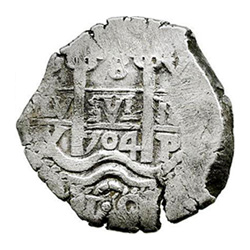 Silver pillars and waves - Instead of a crowned shield, some silver cobs use this pillars and waves design. Most of the time, only part of the design is actually visible. In the example here, the 8 at top center means 8 reales, and the 704 just above the waves is the date (1704). Collectors will pay premiums for visible components such as these. Silver reales with pillars and waves were produced only in Bolivia and Peru.
Silver pillars and waves - Instead of a crowned shield, some silver cobs use this pillars and waves design. Most of the time, only part of the design is actually visible. In the example here, the 8 at top center means 8 reales, and the 704 just above the waves is the date (1704). Collectors will pay premiums for visible components such as these. Silver reales with pillars and waves were produced only in Bolivia and Peru.
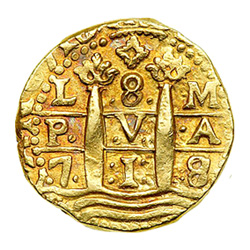 Gold pillars and waves - Instead of a crowned shield, some gold cobs use this pillars and waves design. Most of the time, only part of the design is actually visible. The example pictured is extraordinary. The L - 8 - M on the top row gives the mint mark (Lima), the denomination (8 escudos), and the assayer initial. The middle row, P - V - A, is an abbreviation for PLUS ULTRA or more beyond. The bottom row, just above the waves, gives the date as 1718. This is a very valuable coin. Collectors will pay premiums for visible components such as these. Escudos with pillars and waves were produced only in Peru.
Gold pillars and waves - Instead of a crowned shield, some gold cobs use this pillars and waves design. Most of the time, only part of the design is actually visible. The example pictured is extraordinary. The L - 8 - M on the top row gives the mint mark (Lima), the denomination (8 escudos), and the assayer initial. The middle row, P - V - A, is an abbreviation for PLUS ULTRA or more beyond. The bottom row, just above the waves, gives the date as 1718. This is a very valuable coin. Collectors will pay premiums for visible components such as these. Escudos with pillars and waves were produced only in Peru.
About CoinQuest | Privacy Policy | Contact CoinQuest
Copyright 2009 to 2024 CoinQuest.com, all rights reserved.
Daily visitors 278, minutes per visit 7.3, daily coin views 728